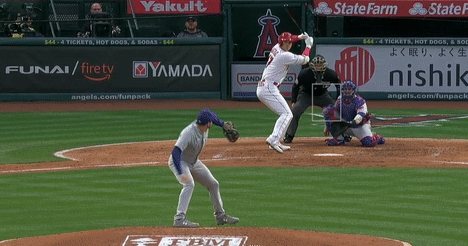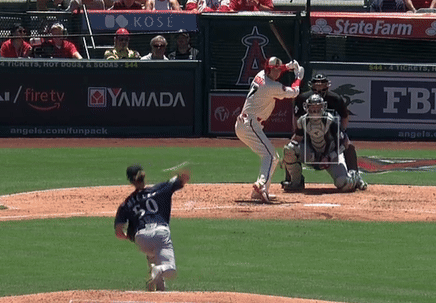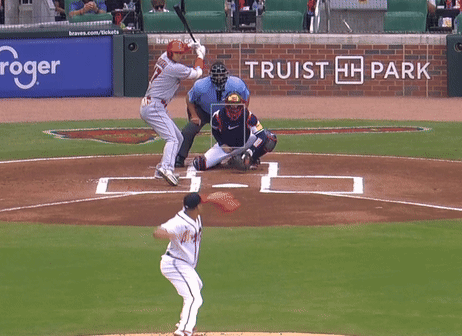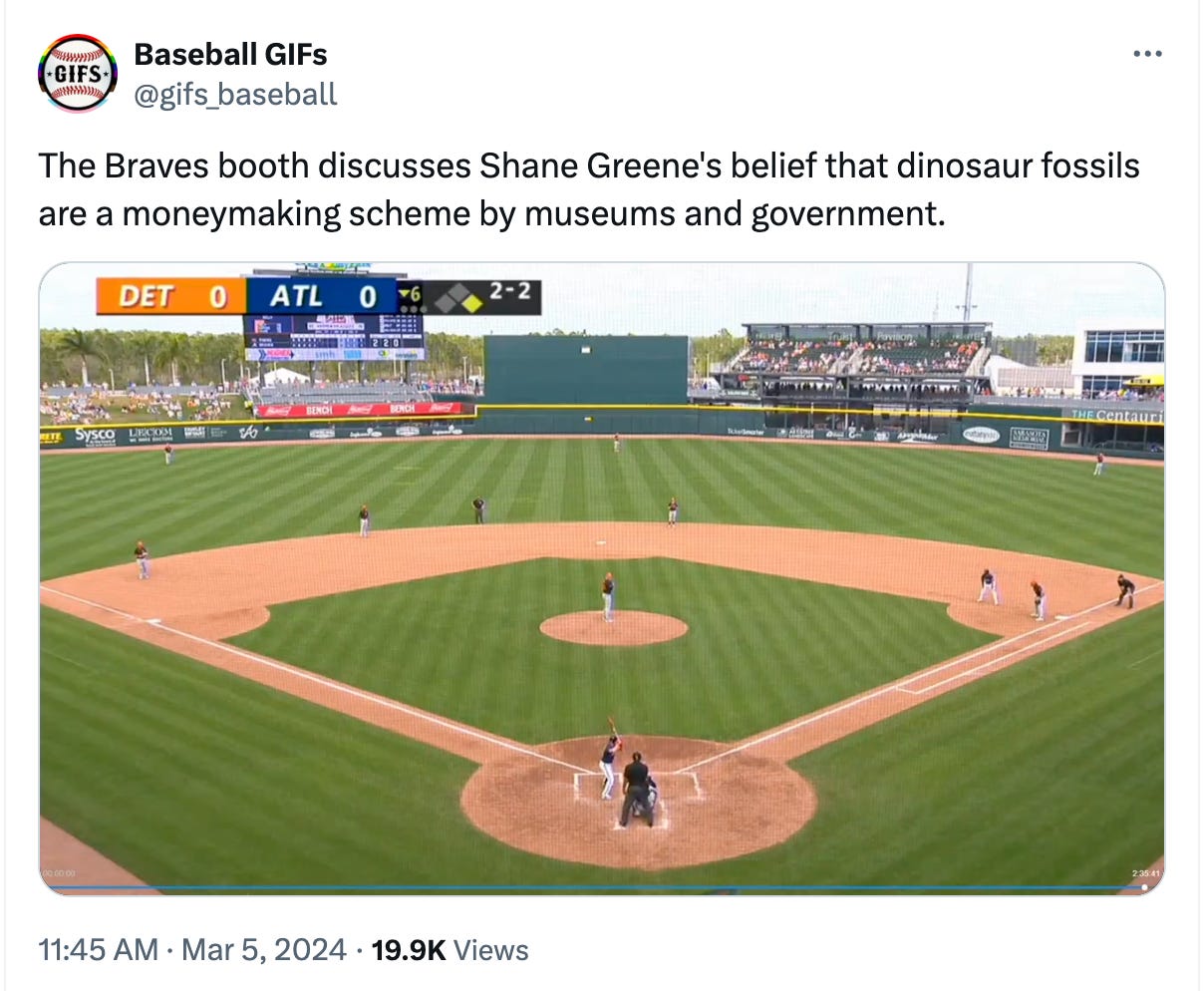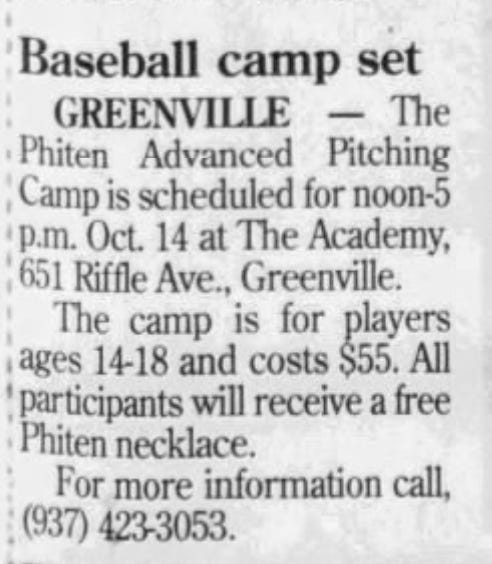I started this newsletter a year ago today. Throughout that time, I’ve been jotting down article ideas in my little tickler file. If I haven’t gotten to them yet—for any of a million reasons—I probably never will. So, rather than let them taunt me with their unspent potential, and rather than be continually distracted by them, I’m going to blurt out a bunch right now.
I’ll do five today and probably five a bit later in the week. At the end of part two, I’ll probably do a little assessment of how I think this whole Pebble Hunting project has gone so far, what you might expect from it going forward, an expression of my gratitude, etc. For now: short articles about long articles that will never be written by me.
1. A Visual Guide To Shohei Ohtani Looking Like He Hurt Himself Swinging
Shohei Ohtani takes big swings, which look like the sort of swings that could cause one to injure himself if things went a little wrong. Ohtani never gets hurt on these swings, but for some reason he often acts like he did. Just now, it took me practically no time at all to find four good examples of this phenomenon:
Does this not look like an oblique strain and 6-8 weeks on the IL?
And does this not look like a tug around the glute, probably just day-to-day, but when he triples as a pinch-hitter four days from now doesn’t it look like something he’ll re-aggravate and be out for 4-6 weeks?
And does this not look like he janked his knee real bad? Don’t you expect from this janking that when he next tries to pitch his knee is going to start to stiffen up around the third inning, and he’ll have to leave the game immediately with a pitching line that’s something like 2 1/3 innings, no hits, no runs, four walks and seven strikeouts?
And does this not look like he strained a pec, and you know how finicky pecs can be?
Was he actually hurt on any of these swings? No. If you had been an Angels fan watching them, though, would you not have felt brief panic seeing Ohtani’s many cringes, flinches, grabs, hunches and startles? Assuming, I mean, that as an Angels fan your baseline expectations hadn’t already sunk so low that you were incapable of being surprised by disappointment?
I don’t have a cogent theory for why he does this performance of presumably fake pain, which seems almost operatic to me. If I’d written the article, I’d have formed one, but I’m not going to. Any theory might also have to explain why, when he fouls pitches off, he often yells out warnings to the people in the section, which feels more dramatic than actually helpful.
2. You Have To Be Yes, Yes, Yes, No.
Mets broadcaster Gary Cohen (in September): That’s what Buck [Showalter] always says: You hit until you take, you don’t take until you hit.
Giants broadcaster Hunter Pence (in August): The old saying in baseball is you can’t be no, no, no, yes. You have to be yes, yes, yes, no.
These two variations of the same advice—look to swing, don’t look to take; you won’t perform well from a posture of avoidance—are among the deepest baseball aphorisms I was exposed to this year, and they seem applicable to most of our lives in some way or another. I’m not going to get into where they apply in my life, because I’m not writing that article.
They definitely remind me that Robert Orr’s great piece at Baseball Prospectus quantifying Corey Seager’s selectively aggressive approach to hitting is one of my favorite articles of the past year, and everybody here would probably enjoy it.
They might also remind me of the college professor who split the photography class into two groups, one group graded on quantity—how many photos could they take in a semester?—and the other graded on quality, needing to produce only one perfect photo in the entire semester to get a good grade. At the end of the semester, this professor found that all the best photos were taken by the quantity group. “The quality group sat around speculating about perfection. In the end, they had little to show for their efforts other than unverified theories and one mediocre photo,” wrote James Clear, telling the tale in his book Atomic Habits. Does this advice remind me at all of that story? It might, but I’m not sure, because I never got around to writing the post about it.
3. Who Was The Last Player To Wear A Phiten Necklace?
In 2011 and 2012, everybody was wearing magic necklaces with aqua-titanium. Hundreds of major leaguers wore them. If you watch highlights of the 2013 postseason, the necklaces are there. If you watch highlights of the 2014 postseason, the necklaces are gone. Here’s a good video explaining the Phiten years, but as far as I know, the oral history of ballplayers abandoning Phiten necklaces in 2014 has never been written.
Phiten settled a class-action lawsuit and apparently quit making claims about the necklaces’s health benefits, but that happened in 2011, and it stopped zero ballplayers from wearing the necklaces for another year or two:
More likely, Phiten was just a style fad, the fad burst, and as some players quit wearing them most others simply followed the unfaddening. That’s a common enough sequence in fads. But does that explain why they ALL disappeared? Tulip mania collapsed in 1637, but humanity didn’t go out and destroy all the tulips forever; some people still liked tulips. After years of claiming that the necklaces had fixed their sciatica or improved their balance, you’d think some players would have internalized those testimonials and continued to rely on the power of topical aqua-titanium exposure. Ten percent of people believe the flat-earth theory, so why wouldn’t Phiten necklaces still maintain, at the very least, something like 10 percent die-hard believers? I mean: We’re talking about ballplayers.
If I’d gone forward with this newsletter post idea, I’d have watched an obscene amount of footage to try to identify the last player still wearing a Phiten Tornado, and maybe even find the last game he wore a Phiten Tornado. It would have taken a long time, and here I am declaring defeat.
4. Call A Hinder!
Keep reading with a 7-day free trial
Subscribe to Pebble Hunting to keep reading this post and get 7 days of free access to the full post archives.





